Building Rapport: 10 Best Ways to Instantly Build Trust in Sales
Building rapport is the foundation of a strong relationship — both personally and professionally.
In sales, your ability to build rapport with prospects is one of the most important skills (if not THE most important skill) to have in your career.
The old saying “people buy from people they like” still holds true, but in 2023, what holds the most truth is that people buy from people they TRUST.
There’s nothing more rewarding than getting on the phone with a prospect, engaging in dialogue, building a connection, and closing a deal that’s mutually beneficial to both parties.
In this article, we look at the best strategies to build rapport, icebreaker questions, and rapport-building nonverbal cues to watch out for.
Here’s what we’ll cover:
- What Is Rapport Building?
- Why Is Building Rapport Important?
- How to Build Rapport in Sales
- Verbal Rapport Building: Open-Ended Questions
- Nonverbal Rapport Building: Body Language
What Is Rapport Building?
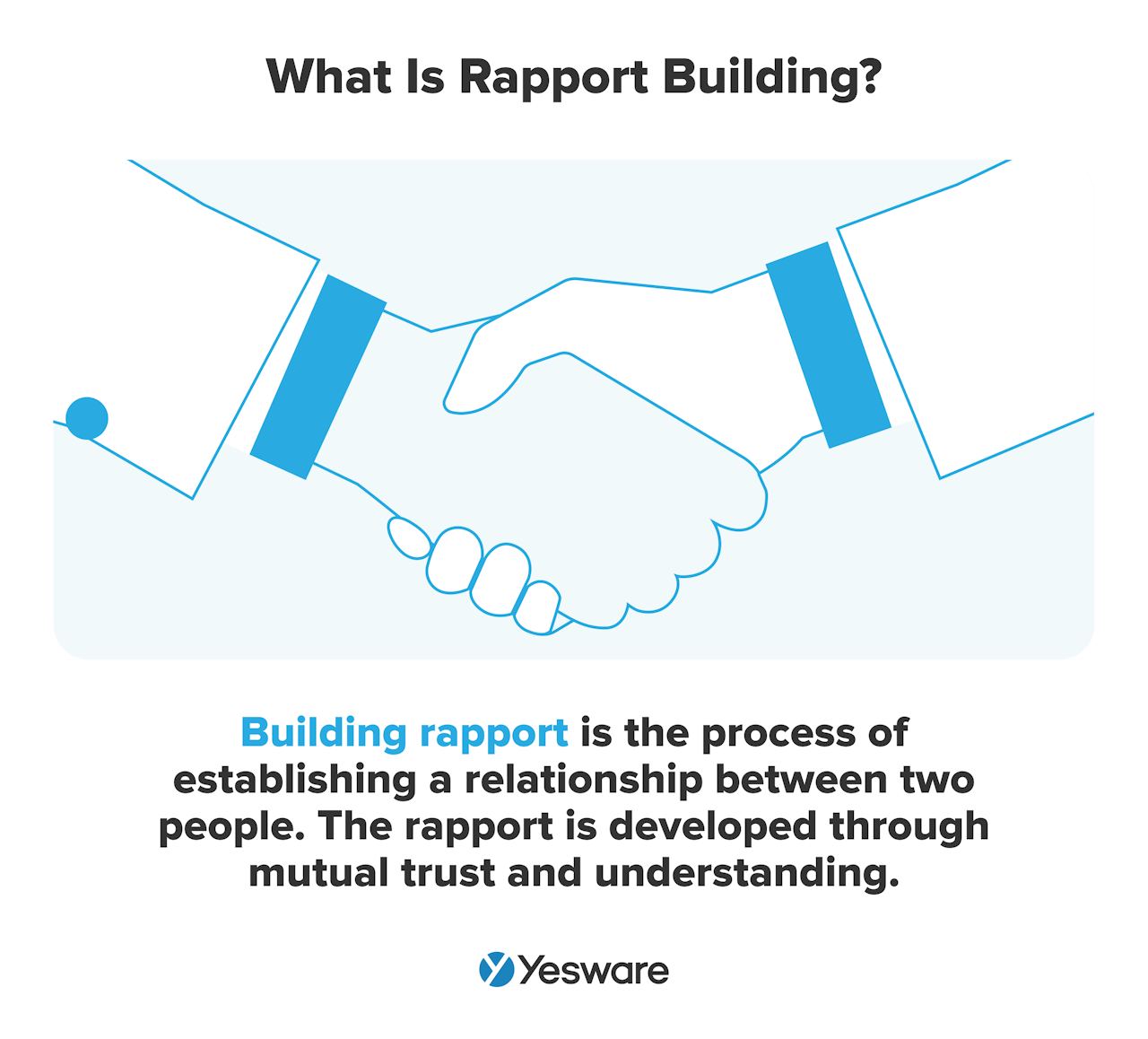
Building rapport is the process of establishing a relationship between two people. The rapport is developed through mutual trust and understanding.
This rapport can stem from shared experiences, interests, and viewpoints.
Building rapport is crucial in sales because people are way more likely to do business with those they know, like, or trust.
Your goal as a salesperson is to build this connection naturally with prospects. Because nothing is better than that feeling of “we just hit it off.”
Why Is Building Rapport Important?
Building rapport is important in both your personal and professional lives.
Being good at building rapport means you’re good at establishing connections, which will get you far in many aspects of your life.
When it comes to sales, building rapport is absolutely essential. Why? Because when you have a strong relationship with a customer, you have more influence on them. And ultimately, they’re more likely to trust and value your opinion.
When a relationship is built with a prospect, there is a much greater chance they become a long-term customer.
How to Build Rapport in Sales
Here are eight of the best ways to build rapport and how you can implement these techniques today.
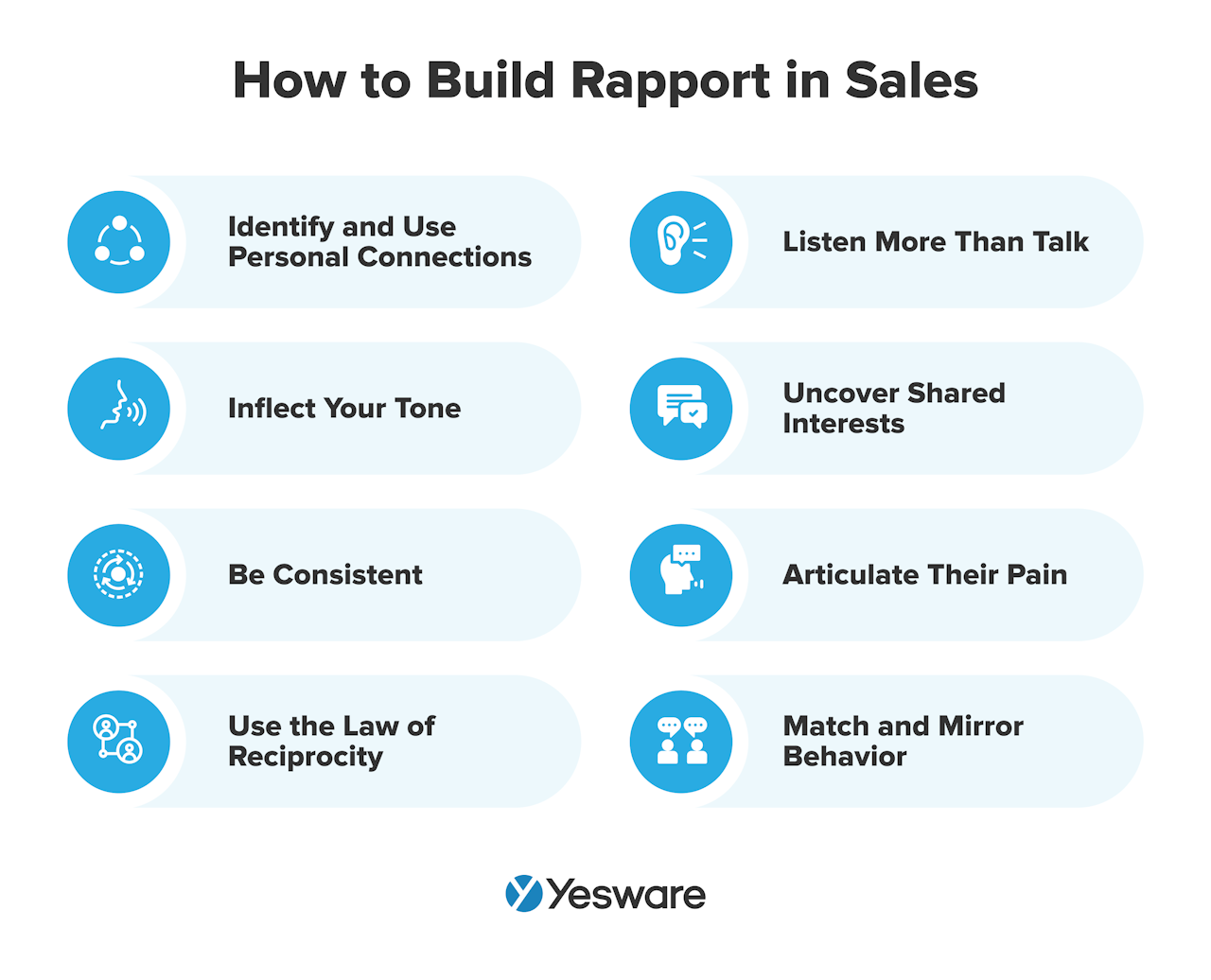
1. Identify and Use Personal Connections
A sales conversation shouldn’t only pertain to conversations about the product/service getting sold. Although the sale is the main focus, try taking a more personal approach and see how the conversation takes a turn for the better.
Building rapport relies on a connection. And the most effective way to connect with others is on a personal level.
Remember, the person on the other end of the call has a life outside of work. Start with their LinkedIn and try to find commonalities. Then, ask them about it to spark conversation.
If you’re having trouble thinking of ways to do so, here are some questions you can try on for size:
- I see you live in [city/state], I’m thinking about planning a trip there soon with my friends, what are your top recommendations?
- I noticed you went to [college/university], I actually have a friend who went there, they said it was really [x]. How did you like it?
- I noticed on LinkedIn you participated in [sport/hobby], I used to play as well, what position were you?
You get the gist. Get them talking about something outside of work to start off the conversation. You’ll help them feel more comfortable and the conversation should flow more effortlessly after this.
Also, you not only show you’re interested in the prospect, but you initiate a conversation where connections can then be built.
Call Template to Build Rapport
A great way to start off your conversation on a positive note is to enter your sales call with a custom sentence that acknowledges something positive about the prospect, such as a recent accomplishment.
Here’s an example of doing this with our spreadsheet created for discovery calls:
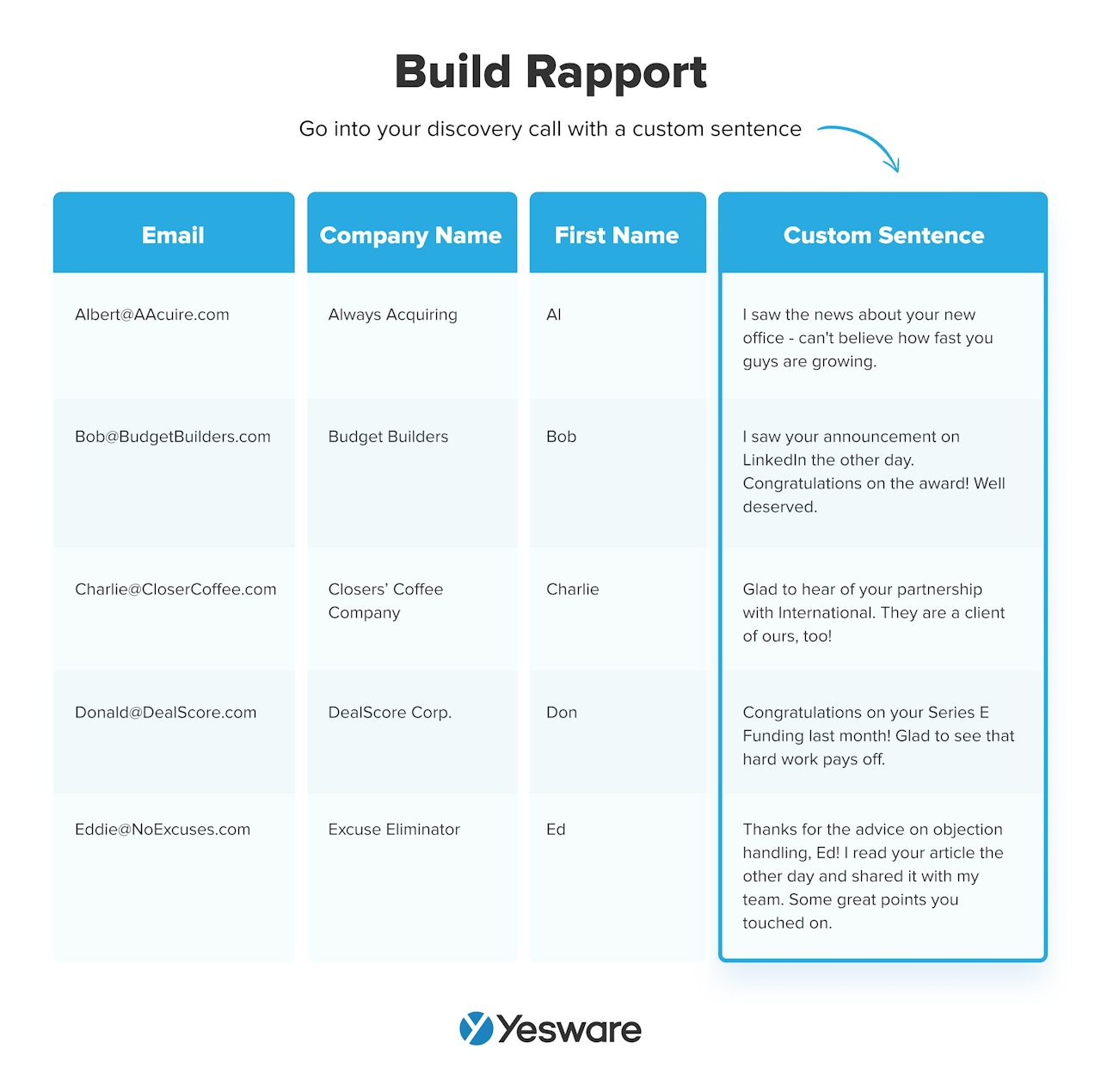
This will help to spark a connection right from the get-go and show you’ve done your research.
They’re likely to have a more positive impression of you when you start the conversation on a high note (because who doesn’t enjoy some flattery?).
2. Inflect Your Tone
Tonality in sales is all-important. Your tone conveys more about your emotions, point of view, and attitude toward the listener than your words do.
According to an analysis of 120 executive speeches by Quantified Impressions, they found that the sound of a speaker’s voice matters twice as much as the message itself.
And we can’t forget the 7-38-55 rule coined by Dr. Albert Mehrabian. This formula states that 55% of communication is achieved through body language, 38% through tone of voice, and 7% through spoken words. 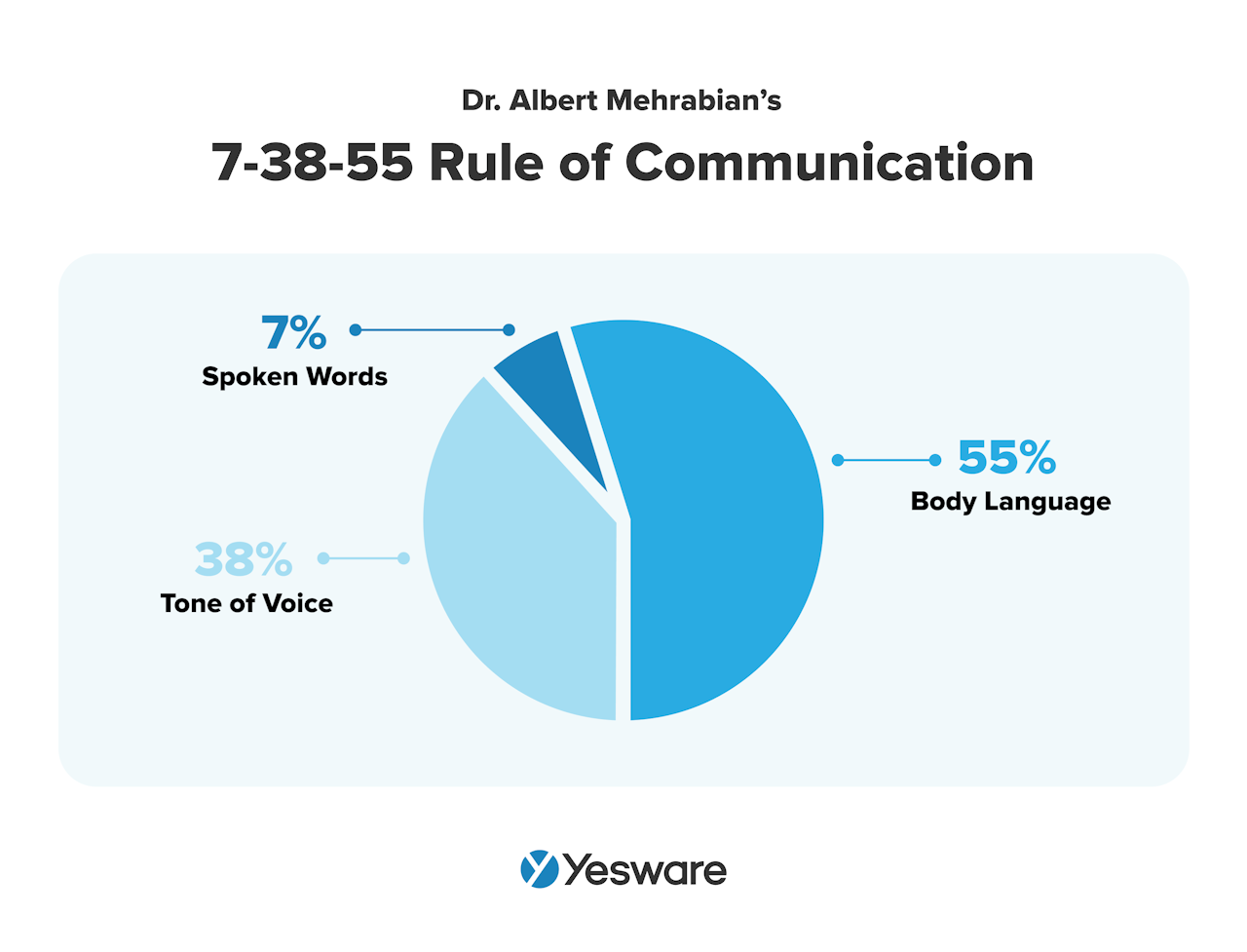 When you’re on a sales call, the prospect can’t see your body language and eye contact, so tone accounts for even more. That’s why perfecting your tonality is so important.
When you’re on a sales call, the prospect can’t see your body language and eye contact, so tone accounts for even more. That’s why perfecting your tonality is so important.
Stay within your normal pitch. Both men and women will lower the pitch of their voices as a way to project authority. But listeners can always tell. You’ll come across as much more authentic and credible by using expressive speech (i.e. shifting from loud tones to soft tones) within your normal range.
Tip: Even when you’re on the phone and the person on the other line can’t see you, watch your posture. Your body language and posture affect the tone of your voice.
3. Be Consistent
Consistency is one of the most important traits to have for any customer-facing role when it comes to building rapport.
Be consistent and follow through with your promises. Studies show that when a customer can predict your behavior, they are much more likely to trust you.
Consistent activities deliver consistent results. Follow a process and stick to it; it’s as easy as that.
Little things like showing up to a meeting on time, sending an agenda, and sticking to the agenda will make more of an impact than you think. If you say at the beginning of the call that it will only be 15 minutes, stick to that time frame.
One way to maintain consistency is to always make clear when scheduling your meeting what the meeting type is, the duration, the meeting agenda, etc.
Here’s a generic example of how to do this with Yesware’s Meeting Scheduler.
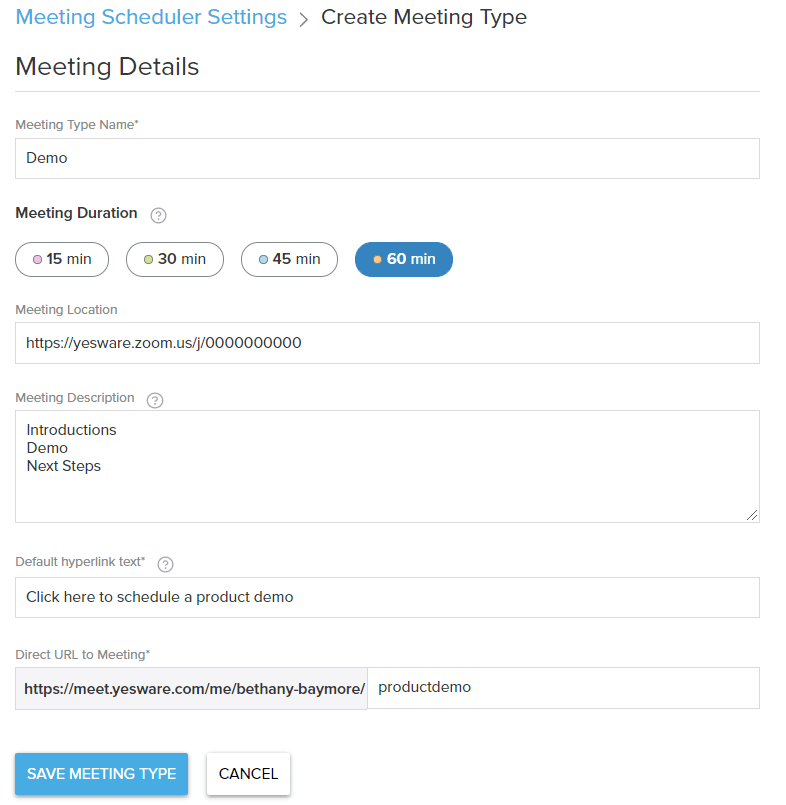
What you put here should remain true throughout the meeting – stick to the duration and the agenda you attached.
Also, make sure to follow through with your client and keep your promises. You have to not only gain their trust but maintain it.
4. Use the Law of Reciprocity
You need to give in order to get. This is the power of reciprocity.
The Law of Reciprocity is one of Robert Cialandi’s principles of persuasion – people are obliged to give back to others in the form of a behavior, gift, or service that they have received first.
In psychology, reciprocity is a universally accepted social rule. This social norm is instinctively engraved in us. And this can actually play a huge role in your sales outreach.
When you understand this equation, it’ll help you in various aspects of sales. 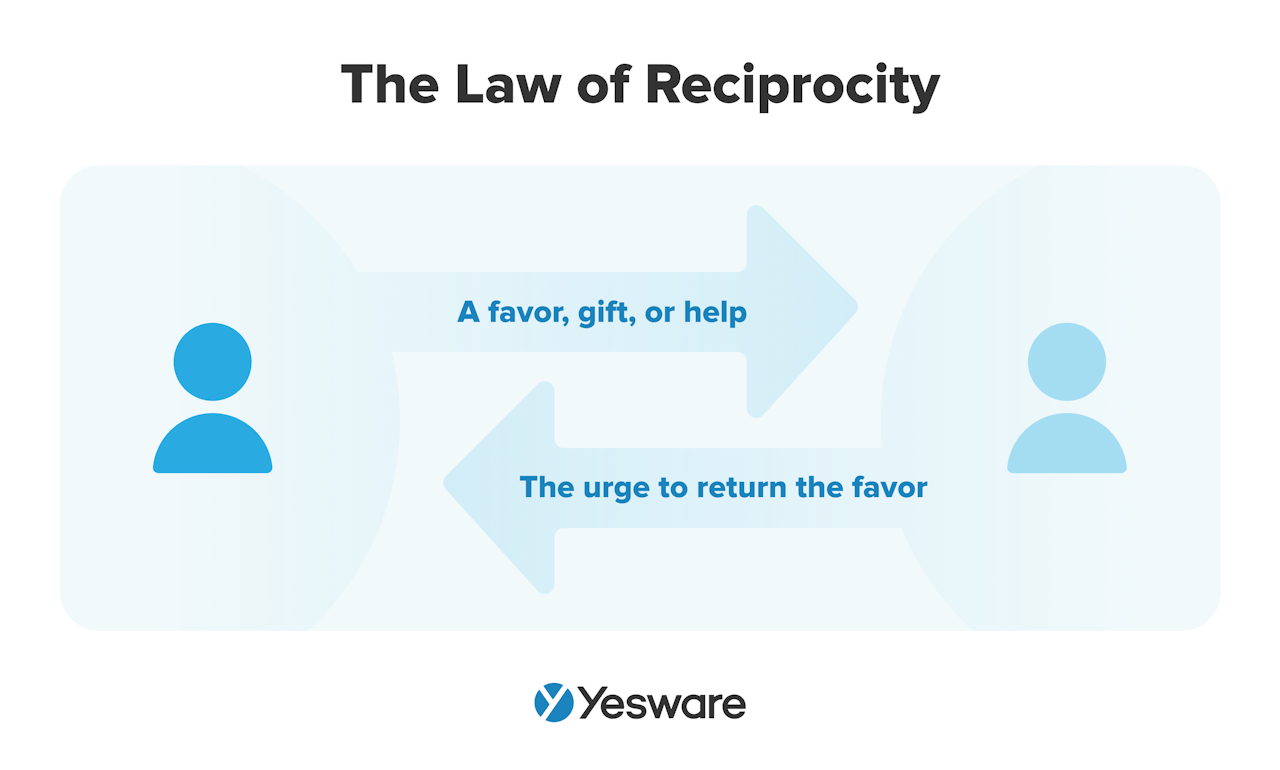 How can you provide value in cold emails and cold calls? The first step is to research their company and role.
How can you provide value in cold emails and cold calls? The first step is to research their company and role.
Look at their company website, their blogs, company social accounts, articles on current events, company updates, etc. There’s boundless information online to learn all about your prospect and their business.
Identify some key ideas that could help and provide value to the prospect and their company, such as:
- Invite them to a conference or event
- Make suggestions that could help their business
- Provide them with relevant articles
- Introduce a business connection
- Introduce a possible candidate for an open position
- Give them tips about top blogs for the industry
- Recommendations on free business tools
The list goes on and on.
Even if it’s much smaller than these, show them you’re genuinely interested in helping them rather than only focusing on selling your product or service.
If your role is to focus on helping them, the return will come naturally. AND it’ll undoubtedly help build rapport.
Email Template to Build Rapport
Here’s an email template for building rapport in cold outreach:
Hi {!FirstName},
{Introduction}.
I’ve done some research into your company and I thought you would appreciate these articles. I thought they did a great job at addressing {!pain point}:
1. {!Link to content 1} – {!description of content 1}
2. {!Link to content 2} – {!description of content 2}
3. {!Link to content 3} – {!description of content 3}
If these resonate with you, let’s grab 15 minutes to see if {!Your Company} can help by {!proposed solution for solving pain point}.
Is there a day or time that generally works best for you?
{!Name}
Tip: Save the template above as an email template that lives in your inbox so you can personalize and send it in seconds.
5. Listen More Than Talk
Your meetings should be a conversation, not a sales pitch.
There’s clear evidence that top sales reps listen more than talk in the discovery call.
Saleshacker found that the “highest yielding” B2B sales conversations hovered around a 43:57 talk-to-listen ratio. So, on average, top sales professionals speak 43% of the time, and prospects speak 57% of the time.

To build rapport, you need to make the sales call as conversational as possible.
People generally like talking about themselves. And by allowing your prospect to do so, they’ll look back on the conversation in a more positive light.
Also, when the conversation is 2-way, they’ll feel more comfortable, like they’re chatting with a friend on the phone.
6. Find Common Ground & Uncover Shared Interests
Finding common ground can significantly help to establish rapport. People like people who are similar to themselves. In psychology, this is known as the similarity-attraction effect.
If you can uncover a similarity with your prospects, you’ll have no problem building rapport.
With all of the information we have at our fingertips to help us understand buyers, there’s no excuse not to research your prospect before the meeting. Social media and the internet have made this easy, giving you the leverage to spark conversation.
Check your prospect’s LinkedIn, Twitter, Google, and public Facebook profiles for shared backgrounds, hobbies, likes, dislikes, etc.
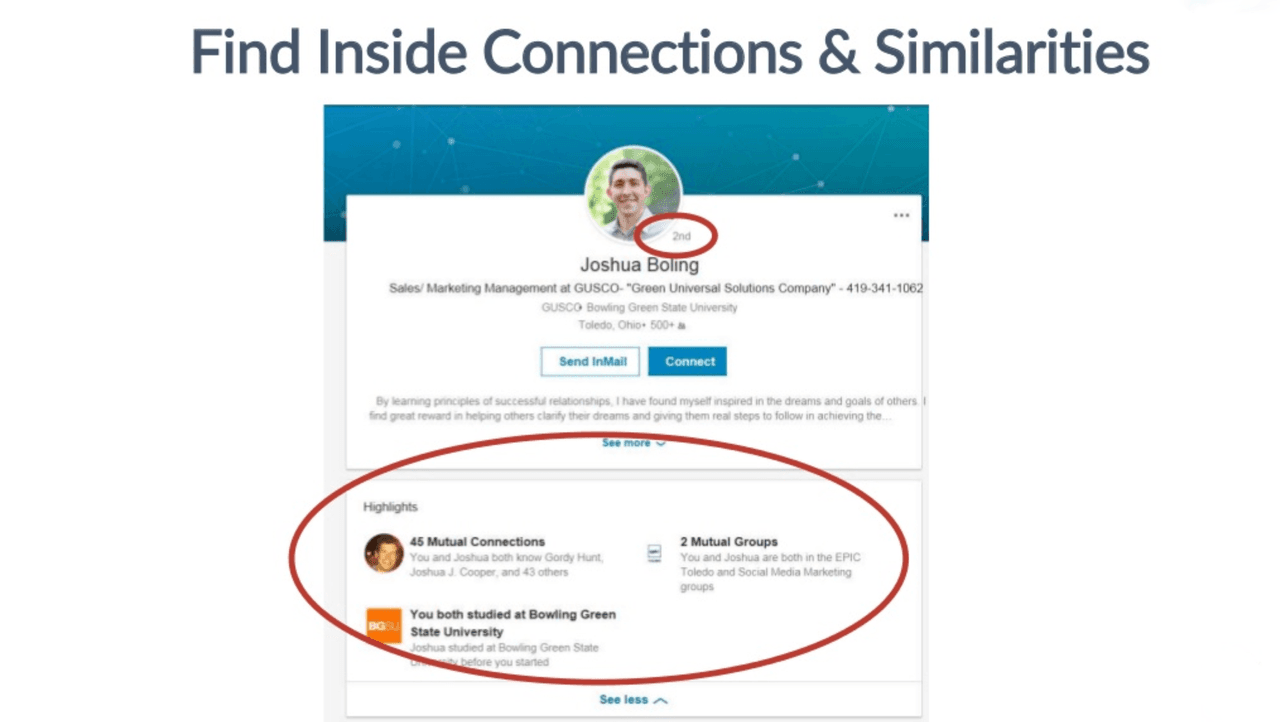
You can find similarities in career backgrounds, educational backgrounds, mutual connections, any connection with the city they’re living in now (build off that – sports teams, favorite restaurants, experiences in that area, etc.), hobbies, interests, the list goes on and on.
Always go into sales calls with a common similarity in mind and/or notes jotted down about the prospect’s experiences.
Your goal is to lead these connections into further conversation. The more you get talking and building connections, the more the relationship progresses and trust can be built.
7. Articulate Their Pain Before They Tell You
Connecting with your prospects on a more personal level will certainly put you ahead, but what’s most important is to show them that you understand their pain points. 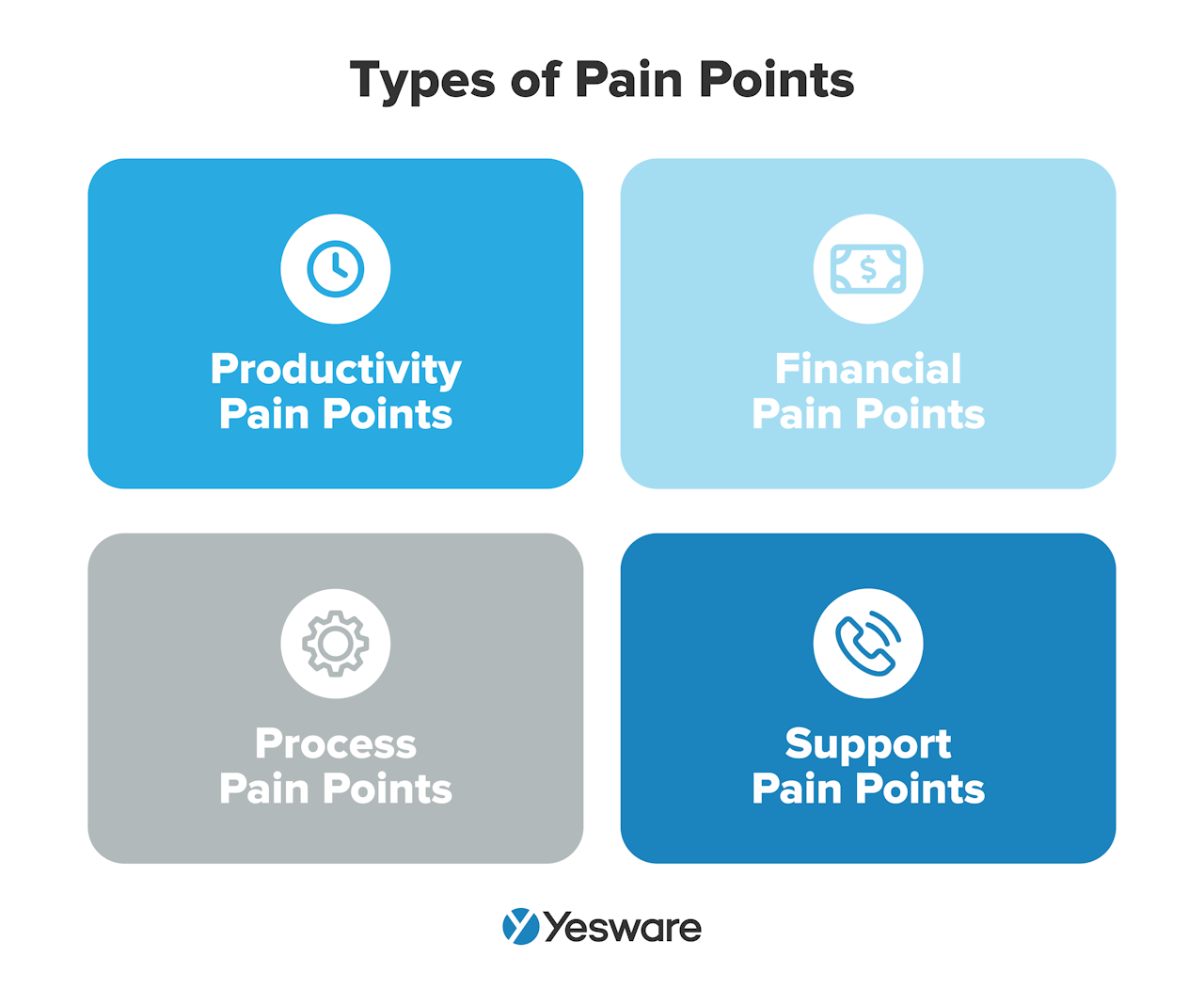 To now strengthen the initial rapport you’ve built, show them that you’re dedicated to understanding their issues and problems and solving these for them.
To now strengthen the initial rapport you’ve built, show them that you’re dedicated to understanding their issues and problems and solving these for them.
What’s surprising is, according to IBM, 78% of customers don’t feel understood by brands.  That’s why it’s important to make your prospects feel understood. By making it clear that they’ve been heard – they’re more likely to listen to the message you’re trying to convey.
That’s why it’s important to make your prospects feel understood. By making it clear that they’ve been heard – they’re more likely to listen to the message you’re trying to convey.
There’s no better way to solve your customer’s pain points than showing that you truly understand them first.
And the best way to fully understand their pain points is to ask open-ended qualitative questions that require an in-depth explanation. This will give you a broader view of the problem and allow you to grasp as much information as possible.
Here are some questions you can ask to uncover your prospect’s pain points:
- What takes up the most time in your day?
- Why isn’t your current solution and/or process working for you?
- What is the biggest challenge you’re currently facing?
- You mentioned frustration around X. Can you elaborate?
- What is preventing you from hitting your goals?
- What’s the main thing you would say is holding your business back from growth?
In the questions above, your role is to carefully listen and pinpoint the issues that your solution specifically can solve. And when you present your solution, your response should be tailored around what the prospect said.
This way, you show active listening and address the prospect’s pain points head-on. 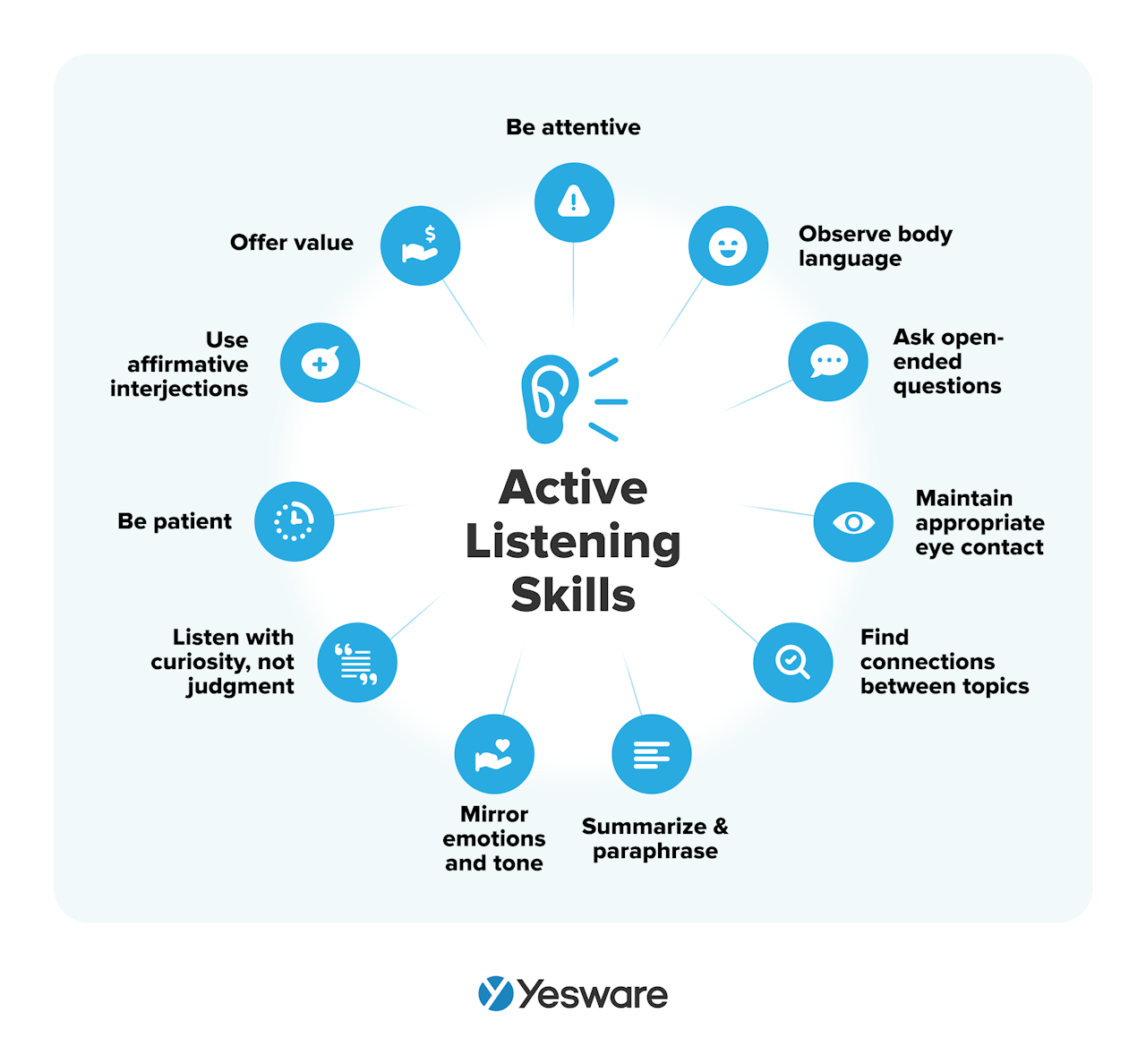 You can demonstrate active listening by rephrasing what the prospect said, for example: “X will help save you hours per day” vs. “You mentioned you waste hours per day logging information; well, X will reduce that by Y.”
You can demonstrate active listening by rephrasing what the prospect said, for example: “X will help save you hours per day” vs. “You mentioned you waste hours per day logging information; well, X will reduce that by Y.”
8. Watch Your Body Language + Match & Mirror Behavior
Mirroring in sales is a powerful psychological technique that helps with building rapport.
When people are engaged in a conversation — and it’s going well — it’s common to see them subtly imitate each other’s body language. Why? Matching behaviors create the sense that people are on the same page and convey feelings of trust and empathy. 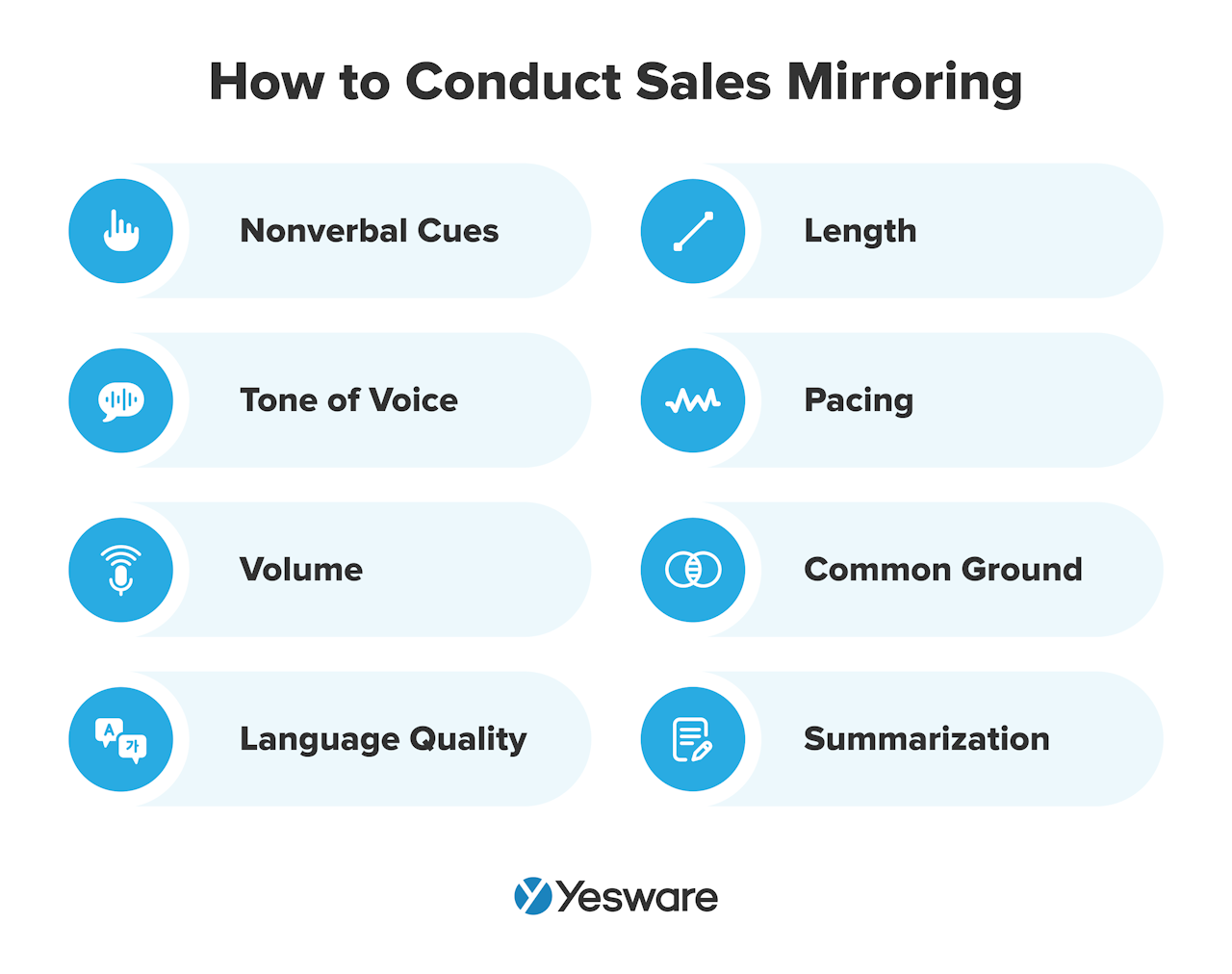 In an experiment, researcher William Maddux tested the impact of this behavior on business negotiations. The results showed that when one student was instructed to mirror the other, the two parties reached a deal 67% of the time. But when they were told not to mirror, only 12.5% reached a deal.
In an experiment, researcher William Maddux tested the impact of this behavior on business negotiations. The results showed that when one student was instructed to mirror the other, the two parties reached a deal 67% of the time. But when they were told not to mirror, only 12.5% reached a deal.
Don’t change your personality, but make slight adjustments to match the prospect’s behavior.
Here are some examples:
- Mirror their body posture to show you’re on the same page.
- Adjust your tone and pace to be more similar to your prospects so they feel more comfortable.
- Match their emotions and energy level to portray a mutual understanding.
Tip: This ebook is filled with psychology-backed tips that’ll help you build rapport and influence buyer decisions through nonverbal and verbal cues.
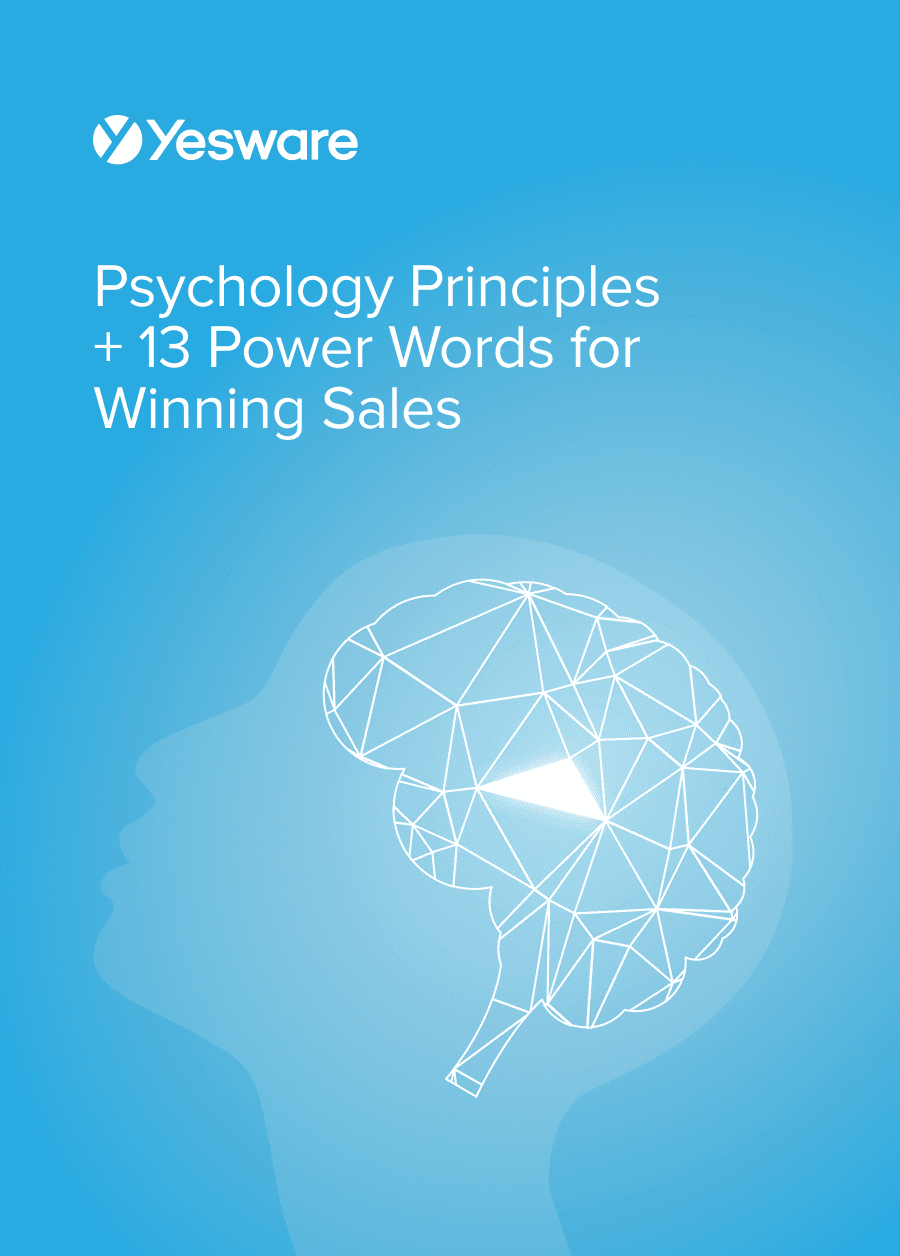 Psychology Principles + 13 Power Words for Winning SalesData-backed psychological principles, nonverbal cues, and persuasive phrases to win more deals.
Psychology Principles + 13 Power Words for Winning SalesData-backed psychological principles, nonverbal cues, and persuasive phrases to win more deals.
Verbal Rapport Building: Open-Ended Questions
Avoid that awkward small talk and focus on asking open-ended questions that will spark conversations and build connections.
Open-ended questions get the recipient talking, which 1) allows you to identify connection builders, 2) allows them to feel more comfortable, and 3) creates a dialogue that flows more smoothly and naturally between the two of you.
Remember, the point of open-ended questions is to avoid all questions that can be answered with a “yes” or a “no,” you want to ask questions that involve in-depth explanations. 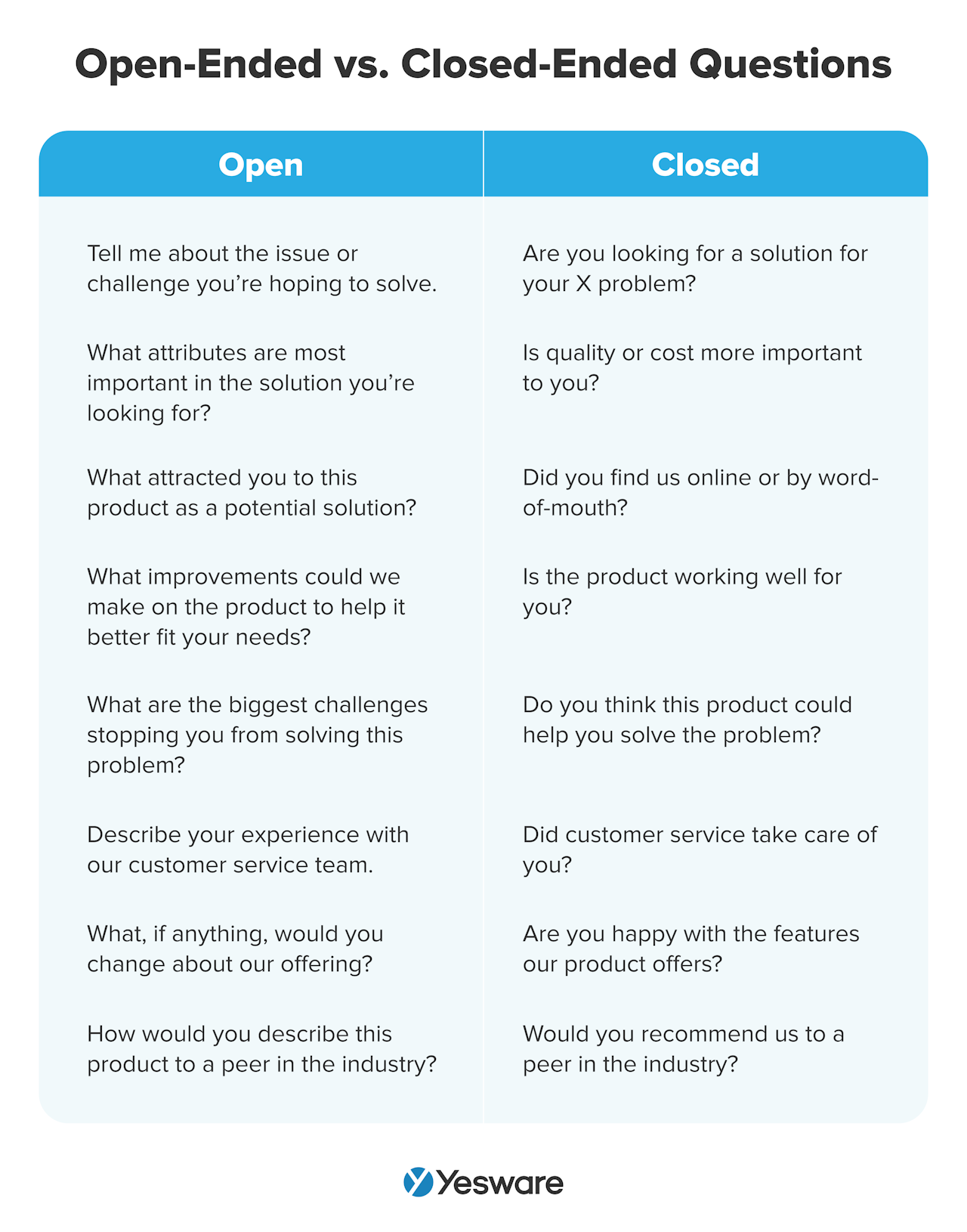 Here are some rapport-building questions that will help break the ice:
Here are some rapport-building questions that will help break the ice:
- I see you live in [city/state], how do you like it?
- I see you live in [city/state], have you ever tried [restaurant/local attraction]?
- Is it true what they say about living in [city/state]?
- I noticed you went to [college/university], I actually have a friend who went there, they said it was really [x]. How did you like it?
- I’m thinking about visiting [city/state] soon, what are your top recommendations?
- I noticed on LinkedIn you participated in [sport/hobby], I used to play as well, what position were you?
- In your LinkedIn summary, you mentioned you love [x]. How long have you been doing that?
- Congrats on [recent company news]! How long has that been in the works?
- I was looking at your site easier and came across [recent company news]. That’s awesome. What has that new process been like?
- I see you used to work for [company] as [position], I know someone who used to work there as well. Do you know [name]?
- I see you changed positions from [old position] to [new position]. I switched career paths as well and it was one of the best decisions I’ve made, although a tough one. What motivated you to go for it?
Nonverbal Rapport Building: Body Language
Data indicates that over 90% of all communication is nonverbal. When building rapport, it’s important to watch your nonverbal communication.
Here are some of the most important nonverbal cues to pay attention to when talking to prospects.
- Make eye contact
- Directly face the person
- Nod along while listening
- Smile
- Make encouraging sounds and gestures
- Avoid fidgeting excessively
- Watch your posture
- Use facial expressions to demonstrate interest
Practice Building Rapport
These tips will undoubtedly help build great relationships with prospects and customers, but it’s important to practice. Practice these techniques with a manager or colleague to help you understand what’s working and what’s not working.
Pick a handful of prospects – do your research, learn about them, and find similarities. Then, role-play the conversation. Get feedback from your manager or colleague – does it sound natural?
The best thing you can do is make it sound and feel genuine and natural. You’re not just putting on an act to get them to like you.
Get critical feedback, keep practicing, and keep trying new techniques to see what works best for you and your prospects.
Once you’ve nailed down your approach, take it to the next level by creating a customized sales call script to keep you on track on each and every call.
This guide was updated on August 1st, 2023.
Get sales tips and strategies delivered straight to your inbox.
Yesware will help you generate more sales right from your inbox. Try our Outlook add-on or Gmail Chrome extension for free, forever!
Related Articles
Melissa Williams
Anya Vitko
Casey O'Connor
Sales, deal management, and communication tips for your inbox

